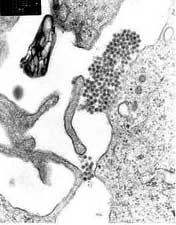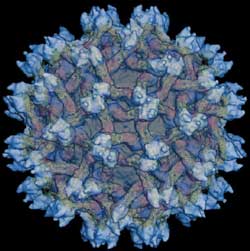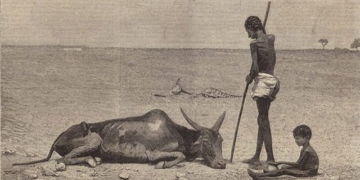Health experts in Ho Chi Minh City warn that there is substantial evidence indicating that the Dengue virus can infiltrate the brain, causing encephalitis known as Dengue hemorrhagic fever.
 |
| Dengue Virus seen through an electron microscope (Image: Wikipedia) |
Currently, the weather is at its peak during the dry season, but experts warn that the risk of an outbreak of Dengue fever is very high. Recently, specialists have alerted that there is increasing evidence that the Dengue virus can invade the brain, resulting in encephalitis known as Dengue hemorrhagic fever.
In the first three months of 2006, nearly 8,000 cases of Dengue fever were reported nationwide, a 20% increase compared to the same period last year. The majority of cases were concentrated in southern provinces such as Ho Chi Minh City, Ben Tre, Ca Mau, Dong Thap, Soc Trang, and An Giang, with 6,017 cases reported and 5 fatalities.
Dr. Nguyen Thanh Hung, Deputy Director of Children’s Hospital No. 1, stated that since the beginning of the year, the hospital has admitted over a thousand cases, of which 10% were in shock. Previously, Dengue fever primarily affected children, but in recent years, the number of adults contracting the disease has been increasing. It is noteworthy that the older the patient, the more dangerous Dengue fever becomes.
Dengue Virus Complications Affecting the Brain
Dr. Nguyen Thanh Hung warns that there is growing evidence that the Dengue virus can invade the brain, causing encephalitis known as Dengue hemorrhagic fever. Furthermore, Dengue fever is often confused with other recent diseases causing encephalitis such as meningococcal disease and hand-foot-mouth disease, each requiring entirely different treatment approaches. Therefore, when a child has a high fever, it is crucial to take them to a medical facility rather than attempting self-treatment. Here are the ways to differentiate:
*Dengue Fever:
 |
|
Dengue Virus (Image: Stanford) |
1. High Fever: The child suddenly has a high fever ranging from 39 to 41 degrees Celsius. The high fever persists for 2 to 7 days.
2. Hemorrhagic Manifestations: petechiae under the skin, bruises, bleeding from injection sites, nosebleeds, bleeding gums, vomiting blood, and blood in stools.
3. Enlarged liver, abdominal pain, and vomiting.
4. Shock (cardiovascular collapse): This usually occurs from day 3 to day 6 of the illness. The child may stop having a fever but feels tired, restless, cries easily, has cold extremities, sweating, rapid and weak pulse, or low blood pressure.
*Hand-Foot-Mouth Disease: also causes fever, but in the initial days, the fever is mild, accompanied by loss of appetite, fatigue, and blisters primarily in the mouth, palms, soles, knees, and occasionally on the buttocks. This disease primarily occurs in children under 3 years old and is rarely seen in children over 5 years old, as most children in this age group have already been exposed to Enterovirus 71 and are immune. The disease progresses very quickly, even faster than Dengue fever, with fatalities occurring within hours. It is easily confused with bacterial infections caused by Staphylococcus and Streptococcus, as well as chickenpox. Chickenpox also presents with blisters but throughout the body and can affect various age groups. In contrast, blistering dermatitis due to bacterial infection typically appears after skin has been compromised due to scratches, scabies, eczema, etc.
*Meningococcal Disease: also known as purulent meningitis. Infected individuals exhibit symptoms such as sudden high fever, cough, sore throat, or may present without cough or sore throat but accompanied by vomiting, chills, muscle pain, coma, shock, and the appearance of purplish-red spots of varying sizes on the skin that resemble a map. This disease is commonly seen in children aged 6 to 36 months, but can occasionally occur in older children aged 15-18 years.
Nhat Phuong


















































